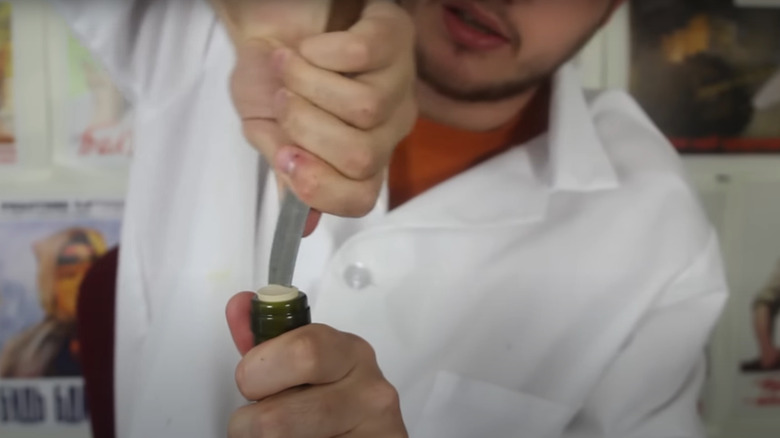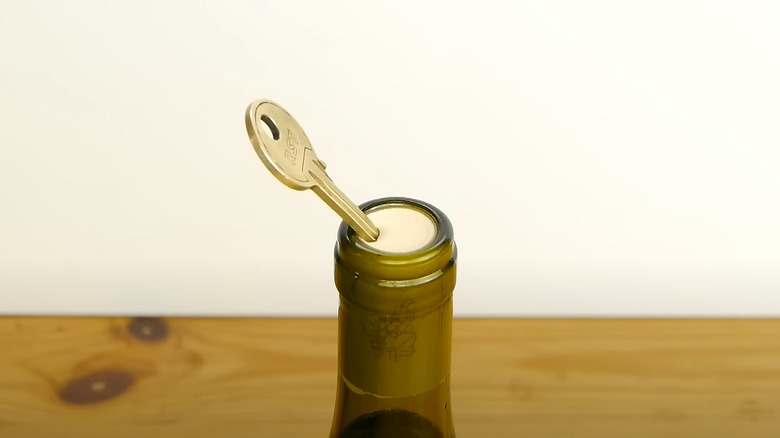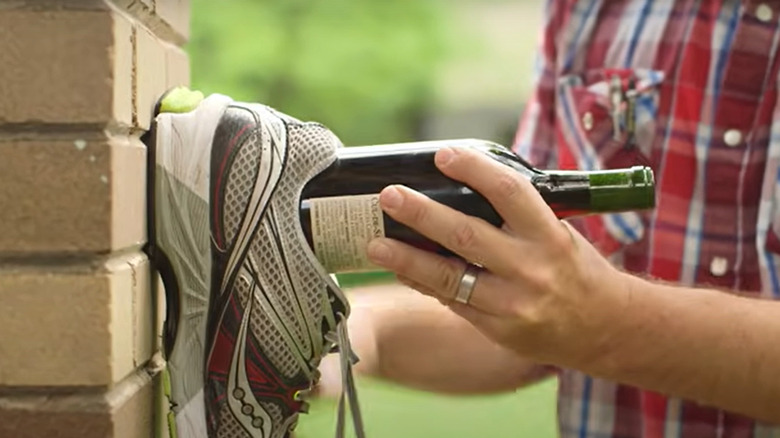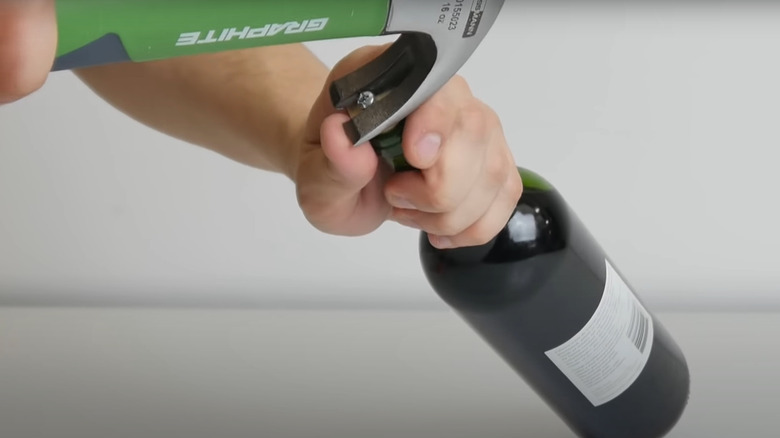5 Reasonable Ways To Open A Cork Without A Corkscrew
The party is in full swing, the wine glasses are sparkling clean and neatly arranged on the table. All that's left is to uncork that expensive bottle of cabernet you've been storing for just the right amount of time for this special occasion. You reach for the corkscrew, but it's nowhere to be found. Panic sets in...
It's a hypothetical scenario, but we're certain many people can relate to this (though if you're actually in need of opening a bottle right now, feel free to skip ahead to the next section!) Fortunately, there are plenty of ways to get that cork out without a corkscrew. But a cursory search online will introduce you to some crazy ideas like slicing the bottle with a saber, to blow-torching the bottle until the cork pops out.
You probably don't have a saber handy unless you have an heirloom saber on your mantelpiece, and most people don't have a ready-to-access mini-blowtorch. Instead, the techniques you'll find here will be more reasonable: popping the cork using a key, an old shoe, or even pushing the cork into the bottle. Just look around your home, pick the easiest method, and go for it to keep the party going!
Just push the cork in
If you're short on time and want the quickest, no-fuss way to open your wine, you can push the cork into the bottle using a flat, blunt object like a marker or the end of a long wooden spoon.
Place the bottle on a stable surface, and position your chosen uncorker in the center of the cork's top. Apply firm, steady pressure downward. You should feel the cork start to slide down after a while. It may take some effort, but eventually, the cork will slip and drop into the wine. Seeing the cork floating in your wine may seem a bit strange, but don't worry, it won't affect the taste at all.
And no, your wine won't get a corky flavor this way — that musty smell only occurs due to problematic production. If your wine tastes off, it's likely because it was already that way from the vineyard, not because you pushed the cork in. Additionally, there may be some cork bits floating in the wine afterward. If that's the case, you can take the bottle and some glasses outside, then strain the wine through a mesh strainer or a coffee filter so that your guests won't have any cork pieces in their drinks.
Use a knife to shimmy the cork out
If you have a small, sharp knife like a paring knife handy, you can carefully pry the cork out of the bottle. Insert the blade into the cork at a slight angle, with the tip pointing towards the center. This will give you some leverage. Slowly twist the knife while gently pulling upward. As you twist and pull, the cork should begin to move up and out of the bottle.
Exercise caution when using this method, as there's a small risk of the knife slipping through the soft cork and causing injury. Use gentle, controlled motions, and keep your hands and fingers away from the blade's path.
Since you'll be cutting into the cork, having some cork bits in the wine is almost inevitable. If that happens, like with the step above, you may want to strain the wine through a mesh strainer or cheesecloth before serving to remove any floating pieces.
Repurpose an old key into a makeshift cork opener
Do you have a bunch of old keys lying around gathering dust? Now's the perfect time to put them to use! Fish them out, give them a good rinse to remove any dirt or rust, and you've got yourself a makeshift cork opener.
Start by inserting the key into the cork at a 45-degree angle. Hold the bottle firmly with one hand and use the other to twist the key in a circular motion while gently pulling upward. The key's teeth will dig into the soft cork as you twist and pull, allowing the cork to slowly start emerging from the bottle. This method is similar to using a knife, but a bit safer since even if the key slips, it's unlikely to cause injury. The downside is that it's a slower process than a knife since the serrated edge of the key isn't as sharp as a knife blade.
You can also use your house key for this if you don't have any spare ones, but we don't recommend it — applying too much force could potentially break your key. While not as efficient as a traditional corkscrew, using an old key is a clever way to open that wine bottle in a pinch.
Slap the cork out with a shoe
Believe it or not, you can open a wine bottle with a shoe! First, remove any foil or covering from the cork. Then, place the base of the bottle inside a shoe, with the bottom resting against the heel. Find a sturdy wall and gently tap the shoe's heel against the wall while holding the bottle and shoe securely — you may need more force than you think, but start off light. The impact should cause the cork to slowly start emerging from the bottle.
The shoe acts as a cushion for the glass bottle, preventing it from directly striking the wall. Don't worry about accidentally breaking it -– wine bottles, especially those used for sparkling wines like champagne, which are extra-reinforced to withstand the pressure the fizzy liquid is under, can be surprisingly sturdy. With the shoe's padding, you should be able to tap it without the bottle getting so much as a scratch.
Keep tapping the heel against the wall until the cork has risen enough to pull it out by hand. It can be a bit scary, but if you have no other options, why not try?
Screw down the cork
This next (and last option) is for those who have a toolbox in the house. Find a long, metal screw with broad threading and gently tap it down the center of the cork using a hammer – about half an inch and deep enough that the thread can grip the soft cork without the pointy end of the nail puncturing through the cork and to the wine on the other side. Alternatively, you can also use a screwdriver to drive the screw down.
Once the screw is securely in place, hook the claw of your hammer around it and pull upward. The threads should hold onto the cork well, helping it come out smoothly and quickly. You can then remove the cork by hand or with pliers if needed.
It'll be great to find new screws and a hammer that's not too oil-stained. However, if your tools are dirty and you're concerned about cleanliness, rinse the hammer and screw under the tap before starting. But don't stress too much about it — done right, the screw won't come into contact with the wine!





